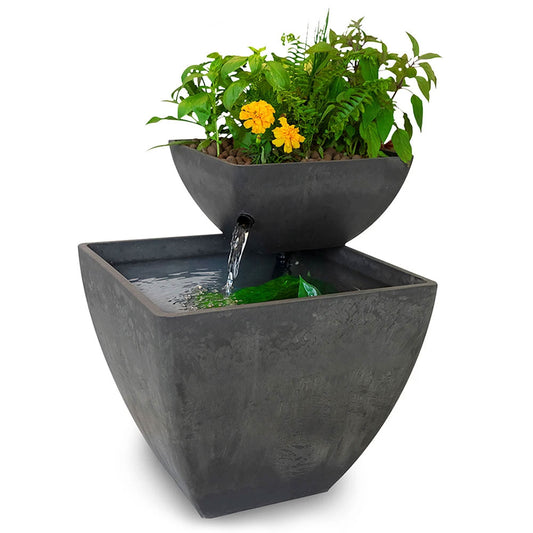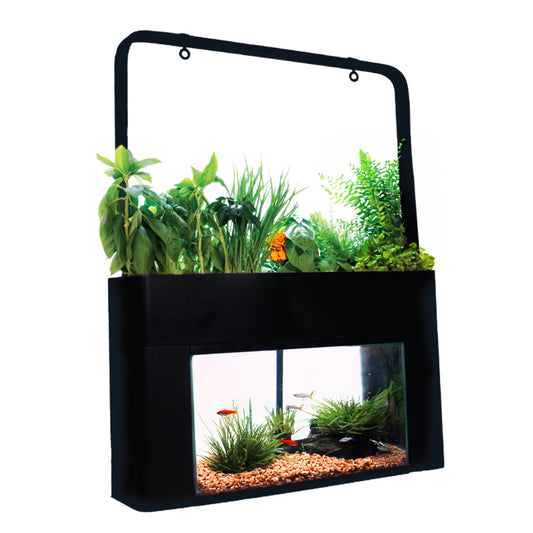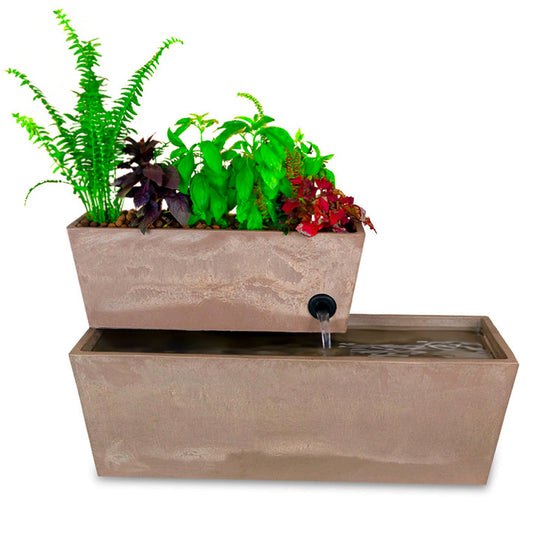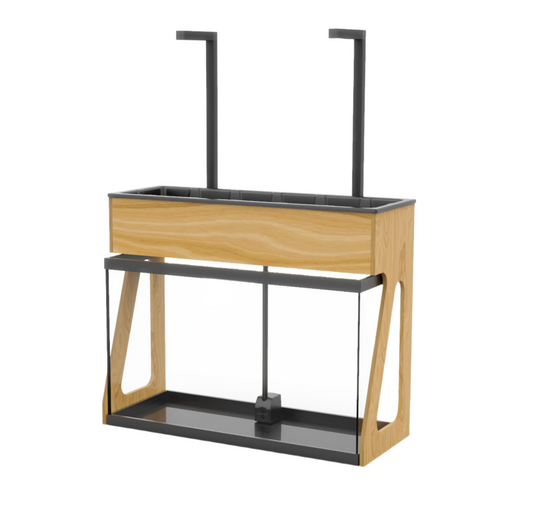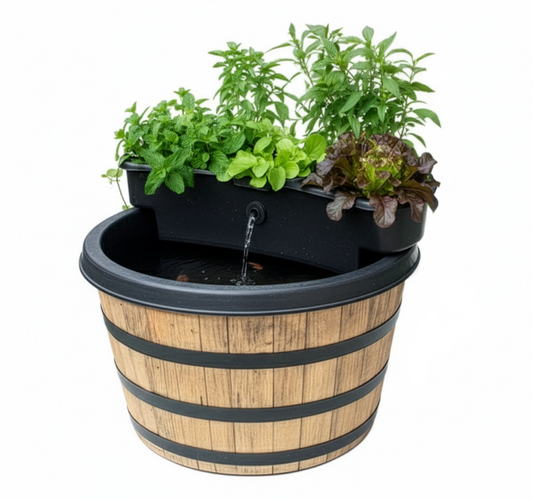The AquaSprouts Medium


Managing pH can be one of the most challenging - or at least most maintenance-intensive - aspects of aquaponics. The nitrifying microbes that make aquaponics possible are constantly digesting the nitrogen-rich wastes your fish produce, but the byproducts of the nitrification process drive down pH[1]. Aquaponic farms manage this in a few different ways, but the techniques employed generally rely on a large volume of water, daily testing and adjustment, or specialized automatic dosing equipment.
Smaller systems can be challenging, because there’s often no reservoir or sump, and a smaller total volume means that chemical changes are spread out over less water and can happen very quickly. It’s also often not cost-effective or desirable to use constant testing or automation, especially for a garden that’s meant to be simple, and accessible to everyone. This added complication can be an unpleasant surprise for someone who’s new to aquaponics and thinks a small system might be an easy, low-maintenance way to try it out!
So what does this all have to do with our clay pebbles? Well, unlike most expanded clay pebble growing medium, AquaSprouts pebbles contain some soluble reactive minerals. The most common problem mineral in aquaponics is calcium carbonate, which occurs naturally as limestone, chalk, and in seashells. If you have hard tap water, it’s probably from dissolved carbonate. Carbonate is a buffer, which tends to stabilize pH by absorbing and neutralizing acids in the water. Unfortunately, it does so at a higher pH than is desirable for optimum plant growth. Our clay pebbles actually contain little to no calcium carbonate, but there are related compounds that can drive up pH in different ways - calcium oxide and magnesium oxide. Both are bound up with the nonreactive oxide minerals that make up >95% of the mass of the material, but in water (especially highly solvent purified water) some will leach over time. Magnesium oxide (MgO) is not very soluble without an acidic environment, and will typically not increase pH beyond neutral. Lime - calcium oxide (CaO) - is the major constituent of mortar and older styles of cement; it reacts with water to produce calcium hydroxide, which is alkaline and moderately soluble. AquaSprouts’ clay pebble medium contains trace amounts of both.
While experimenting with different media for the AquaSprouts Garden, we found that, while Gardens employing the type of pH-neutral clay pebbles most aquaponics and hydroponics use were prone to pH instability, using a clay pebble medium with some alkaline minerals in it counterbalanced the tendency of small systems to rapidly become acidic. Systems using other clay pebble media required pH adjustment daily, and sometimes still became too acidic. The gardens which used our buffering media needed some adjustment early in the life cycle of the system, but they needed pH adjustment downward rather than upward.
We've found that this effect decreases significantly in the first few weeks, and is more often than not actually helpful in cycling a new system. Acidification and ammonium lockup[2] is one of the most common ways that aquariums fail. The alkalinity of our grow media turned out to be a happy accident which led to a greater rate of user success in the long term. It works well with fishless cycling, which we generally recommend, since exact pH maintenance is not so important in an unpopulated system and nitrifying bacteria actually perform better in a higher pH.
The amount of pH drift and how long it takes to reach a point of balance with natural acidification in a biologically active system depends on source water chemistry, and the rate of feeding and nitrification. A moderately high pH (7.4-8.0) can be hard on some types of fish, and it makes mineral absorption difficult for plants. It can be adjusted downward with the addition of simple natural acids; phosphoric acid is a common pH-lowering additive which also provides a bit of extra phosphorus for plants. Using source water with less alkalinity will help keep the pH from drifting up and staying up; if you have hard water, consider filling your tank with ⅓-½ dechlorinated tap water and the rest with reverse osmosis (RO) purified water. Systems filled with soft or very pure water may not need adjustment downward at all, but don’t use purified water alone; fish and plants still need some electrolytes and minerals in the water to live! Heavily stocked systems with lots of nitrification activity may also not need any downward adjustment, and may even still need occasional adjustment upward.
In short, we found that using a clay pebble medium with some alkaline mineral content significantly increased the pH stability of Garden systems, which in turn means less risk of a crash and less required maintenance. The AquaSprouts Garden can still be used with any other appropriately sized medium of your choice, but we selected ours specifically to help make your aquaponic experience just a little easier.
Got more questions, or feedback about your experience with the AquaSprouts Garden? Get in touch with us on our Support page, and keep an eye on the blog for more info and tips!
1: Specifically, ammonia (NH3) is oxidized into nitrite (NO2) and then nitrate (NO3). This means that the three hydrogen atoms attached to the central nitrogen atom in ammonia are replaced with oxygen and kicked out into the surrounding water. While each free hydrogen nucleus (the nitrogen and oxygen keep the shared electrons) is conventionally represented as H+, water actually naturally contains molecules which have traded hydrogen, creating hydroxide (OH-) and hydronium (H3O+) ions; in pure water, the two are in balance and their charges cancel out, so pH is neutral. When substances dissolved in the water release or bind hydrogen molecules, it creates an imbalance between hydroxide and hydronium, and this imbalance is what the pH scale represents.
2: In acidic environments, ammonia {NH3) will take on another free hydrogen and become ammonium (NH4+). The lower the pH, the more ammonia will be present as ammonium. Ammonium is a nontoxic salt that doesn’t react in the same ways ammonia does. It won’t harm fish… but nitrifying bacteria can’t process it. If the pH in a system drops very low, ammonium can build up to significant concentrations in the water even though nothing may appear to be wrong; meanwhile, the biofilter is starving. This ammonium lockout is extremely dangerous!. An increase in pH will cause ammonium to revert to highly toxic ammonia. Adjusting pH upward is a natural response to a low pH reading, but doing so without checking ammonia first can be deadly. Even a water change may trigger disaster, because ammonium may be present at high enough quantities that removing half of it or more may still leave enough to be dangerous, and the added alkalinity of the incoming water can cause it to convert. This nightmare scenario is common in new or poorly maintained aquariums and aquaponic systems.

